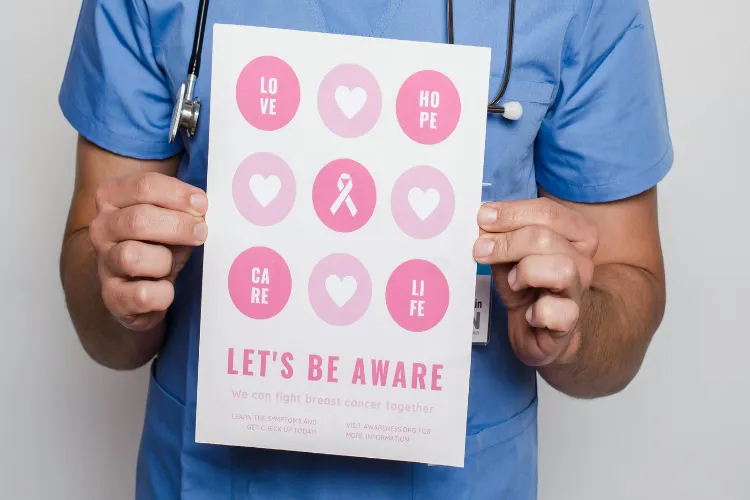Breast cancer awareness often revolves around women, but it’s crucial to remember that men can also be affected by this deadly disease. The stigma surrounding male breast cancer leads to delays in diagnosis and treatment, which can have dire consequences. Experts urge the need to raise awareness about this rare condition to improve survival rates for men facing this diagnosis.
October, recognized as Breast Cancer Awareness Month, brings attention to this often-overlooked aspect of men’s health. According to the World Health Organization (WHO), while breast cancer in men is rare—accounting for just 0.5-1 percent of all cases—it still affects thousands globally every year. Despite its rarity, the disease’s impact can be devastating, particularly when diagnosed late.

Why Is Breast Cancer in Men Diagnosed Late?
A major factor contributing to the delayed diagnosis of breast cancer in men is the social stigma associated with the disease. Breast cancer is traditionally viewed as a women’s disease, leading many men to feel embarrassed or even emasculated when they receive this diagnosis. Dr. Ramesh Sarin, Senior Consultant in Surgical Oncology at Apollo Cancer Centres, explains that the stigma around male breast cancer often causes men to delay seeking medical attention.
“Many men are unaware that they can even develop breast cancer, which leads to late-stage detection. Early diagnosis is key, as it significantly improves survival rates,” Dr. Sarin told IANS.
Common Symptoms and Types of Male Breast Cancer
The symptoms of breast cancer in men are similar to those in women and include lumps or swelling in the chest area, skin dimpling, or changes in the nipple. However, because men are less likely to check for signs of breast cancer, they often miss early warning signs. Dr. Sarin notes that the most common type of breast cancer in men is invasive ductal carcinoma (IDC), which starts in the milk ducts and spreads to nearby tissue. Other types include invasive lobular carcinoma (ILC), Paget’s disease of the nipple, and ductal carcinoma in situ (DCIS), a non-invasive form of the disease.
While these symptoms can easily be mistaken for less severe issues, men must be aware of the potential risks and take any changes seriously. Early detection, as in women, can significantly improve treatment outcomes.
Overcoming the Stigma: A Call to Action
The stigma surrounding male breast cancer doesn’t just affect how men feel about the diagnosis; it also directly influences how quickly they seek help. In many cases, men are hesitant to talk about changes in their breast tissue or visit a doctor out of fear of being ridiculed or misunderstood. This can lead to advanced-stage cancer diagnoses, where treatment options become more limited and the chances of survival decrease.
As awareness around breast cancer grows, it’s vital to include men in the conversation. Health experts, organizations, and media campaigns must work to break down the misconceptions that breast cancer is exclusively a women’s issue. Men need to be empowered to recognize the symptoms and seek early intervention without fear of stigma or shame.
“It is essential to raise awareness that breast cancer doesn’t discriminate by gender,” Dr. Sarin emphasizes. “The earlier the diagnosis, the better the prognosis.”

Treatment and Prognosis
Once diagnosed, the treatment options for male breast cancer are similar to those for women. Surgery to remove the tumor, chemotherapy, radiation, and hormone therapy are among the most common treatments. However, the stage at which the cancer is diagnosed plays a significant role in determining the outcome.
Survival rates are high when breast cancer is caught in its early stages, but for men, delayed diagnosis often leads to more advanced cancer that is harder to treat. This is why early detection and awareness are so critical.
Moving Forward: Education and Support
Men need access to the same level of awareness and support that women receive when it comes to breast cancer. This includes education on self-examinations, regular health check-ups, and an understanding that seeking help is a sign of strength, not weakness.
Support groups, both online and offline, should make a concerted effort to include men in their discussions about breast cancer, providing a safe space where they can share their experiences without fear of judgment.
The medical community also plays a vital role in encouraging men to take symptoms seriously and educating the public about the realities of male breast cancer.
Ending the Stigma of Male Breast Cancer

Breast cancer in men may be rare, but it’s a reality that shouldn’t be overlooked. Social stigma plays a significant role in delayed diagnosis and treatment, making it essential to raise awareness and break down misconceptions. Men should be encouraged to recognize symptoms early, seek medical help without fear, and understand that breast cancer doesn’t discriminate based on gender.
As we observe Breast Cancer Awareness Month, let’s ensure the conversation includes the men who silently face this disease. With increased awareness, early detection, and support, we can improve the outlook for men diagnosed with breast cancer and save lives.

